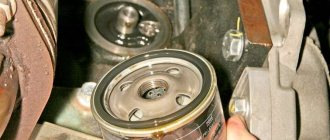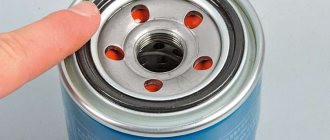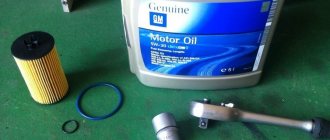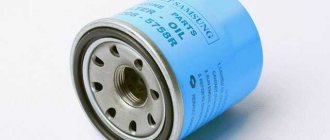The operation of an internal engine is impossible without lubricants. The oil must continuously wash all friction points and rotation points in the mechanisms.
To maintain the functionality of the lubrication system, the engine housing is made in the form of a bath in which a certain volume of technical fluid is constantly located. Using a pump and a complex oil pipeline system, it is supplied to all operating points.
During operation, the lubricant loses its characteristics, so it needs to be renewed periodically. This is a simple operation and can be done independently in a garage. Let's look at the procedure for changing the oil on the popular Volkswagen Polo sedan.
2276-4-8-03
Apply a thin layer of engine oil to the O-ring of the new filter.
We wrap the oil filter by hand and tighten it with a puller to a torque of 20 Nm.
Remove the oil filler cap. From the bottom of the car, clean the oil pan around the drain plug. We place a wide container for draining used oil, with a volume of at least 4 liters, under the drain plug.
What oil is used for Volkswagen Polo
The German automobile concern has a huge number of different engines. The same power plants are used on different models, the Volkswagen Polo sedan is no exception. There is an extended list of motor oil specifications that apply to Volkswagen AG vehicles.
| VW 500.00 | VW 501.01 | VW 502.00 | VW 503.00 | VW 503.01 | VW 504.00 | VW 505.00 | VW 505.01 | VW 506.00 | VW 506.01 | VW 507.00 | |
| Soot deposition | + | + | + | + | + | ++ | + | ++ | + | + | ++ |
| Wear | ++ | ++ | + | +++ | ++ | +++ | + | ++ | +++ | +++ | +++ |
| Sludge deposits | + | + | ++ | ++ | ++ | +++ | ++ | ++ | ++ | ++ | +++ |
| Piston deposits | + | + | ++ | +++ | +++ | +++ | + | ++ | +++ | +++ | +++ |
| Oxidative stability | + | + | +++ | +++ | +++ | +++ | — | ++ | ++ | ++ | +++ |
| Fuel economy | — | — | — | ++ | ++ | ++ | — | — | ++ | ++ | ++ |
| Compatible with aftertreatment systems | — | — | — | — | — | ++ | — | — | — | — | ++ |
| Typical viscosity | Any | Any | 0w 30/40 5w 30/40 10w 30/40 | 0w 30 | 0w 30/40 5w 30/40 | 5w 30 | Any | 5w 30/40 | 0w 30 | 0w 30 | 5w 30 |
In this case, the compliance of the tolerance for a particular motor is determined by the instructions for routine maintenance. For Polo sedan this is VW 502 00. According to the manufacturer’s descriptions, the lubricant is suitable for gasoline engines with a fuel injection system.
The tolerance allows lubricant to be poured into power plants with increased boost, and, accordingly, liter capacity. The European certification for this approval is ACEA A3.
This basic composition is intended for cars that have a standard (in other words, shortened) replacement interval specified in the service book.
In addition, the automaker has certified the VW 504 00 approval, the so-called “Longlife”. Changing such oil in the Polo sedan is done half as often. Of course, provided that the interval is provided for in the service book.
Information
The same engines are installed on other models of the concern: for example, AUDI, Skoda, Seat. Accordingly, Volkswagen approvals also apply to them.
So what kind of oil should you put in the engine? The manufacturer recommends (without directive instructions, otherwise antitrust laws will be violated) the so-called VW branded oil.
While you are being discussed at the dealer service (and you will have to do this, at least during the warranty period), rest assured that this particular consumable will be filled in for you. Then you can choose the brand yourself.
2276-4-8-04
Use a 18mm spanner to loosen the drain plug.
We unscrew the plug by hand and drain the oil.
Attention! Be careful - the oil is hot.
Drain the oil for at least 10 minutes. The drain plug cannot be reused, so we replace it with a new one. We wrap the plug and tighten it to a torque of 40 Nm. We remove oil leaks from the engine oil pan. Pour 3.6 liters of engine oil into the engine through the oil filler neck. Close the oil filler cap.
We start the engine for 1–2 minutes. We make sure that the indicator of insufficient (emergency) oil pressure in the engine has gone off in the instrument cluster, and also that there are no oil leaks from under the drain plug and filter.
We stop the engine. After a few minutes (so that the oil has time to drain into the oil pan), we check the oil level and bring it to normal.
[How to reduce maintenance costs for Volkswagen Polo sedan] [Maintenance of Volkswagen Polo sedan for 15 thousand km] [Maintenance of Volkswagen Polo sedan for 30 thousand km] [Tools required for maintenance of Volkswagen Polo sedan] [ Carrying out maintenance yourself - general recommendations] [Safety rules for carrying out car maintenance yourself]
Changing the engine oil and oil filter Volkswagen Polo sedan
Leaks and problems
The longer the mileage of the Volkswagen Polo Sedan, the more problems appear, as in principle in any car. Most often this is due to natural wear and tear of the engine, causing oil to burn. Although the manufacturer allows for a small consumption.
In general, speaking about the power of this model, it is worth noting that the engines are 105 hp. are not so susceptible to it. But at 1.6 MPI 110 hp. the problem is acute. The manufacturer himself admits this and writes about it in the instructions that consumption can be 1 l/2000 kilometers.
If the car is under warranty and the consumption is 0.5 l/1000 kilometers, then you can go to the dealer. This is a warranty case, but in practice such costs are exceptions. Typically, oil consumption does not exceed 1 l/10,000 kilometers.
Owners note the engine's sensitivity to bad oil. Therefore, it is advised to purchase it from official suppliers to avoid buying a counterfeit. It is also worth reducing the replacement interval and focusing on engine hours; the optimal interval is considered to be 250-300 engine hours.
All this is general information, which may manifest itself differently on each specific vehicle, since everyone’s operating modes are different. The same applies to places of leaks or oil leaks, which cannot be diagnosed from a distance.
When to change the oil?
For all types of Volkswagen Polo engines, in the service documentation, the manufacturer indicates an oil change interval of 15 thousand kilometers or once a year. But if the car often drives through city traffic jams and sits idle, the lubricant ages faster. Therefore, many owners change the fluid a little more often, once every 10 thousand km. This interval will increase the life of the engine. When purchasing a used car, there is no need to delay changing the oil, even if the date indicated in the service book has not yet arrived.
Preparatory work
The preparatory process includes the purchase of all consumables. Below are all the consumables needed for the job.
To receive the waste, prepare an empty 5-liter container (canister). Tools you will need:
- Key to remove the filter.
- Socket wrench No. 18.
- Bat "T-25".
- Head No. 13.
- And a ratchet for removing the crankcase protection.
You should also stock up on enough rags and prepare a funnel.
What should be the viscosity of engine oil according to SAE for VW Polo?
Most often, all-season lubricants with the required characteristics are used. All-season has a double number separated by the English letter “W”, which means the word Winter, “Winter”. The first value indicates what low temperature range the lubricant has, and the second indicates the viscosity at high temperatures. As for low temperatures, the indicators are as follows:
- 0W - designed to operate at ambient temperatures down to -35˚С;
- 10W - allows operation at temperatures down to -25˚С;
- 5W - designed to operate at temperatures down to -30˚С;
- 15W - allows operation at temperatures down to -20˚С;
- 20 W - designed to operate at temperatures down to -15.
As for the second indicator, it is not easy to describe it, since it represents a certain collective value of the minimum and maximum viscosity. Operating temperatures are assumed to be 100 and 150. The higher the indicator, the higher the viscosity value at high temperatures of the engine oil. Based on the above, it should be borne in mind that the Volkswagen Polo sedan oil change should be carried out with fluids that have the following viscosity according to the SAE standard:
- 5W-30;
- 5W-40.
Characteristics of Cordana mix
Cordana is a miniature plant bred by breeders for temperate countries. It came to us from the subtropics of the Northern Hemisphere. The flower feels good both in gardens and in pots on the windowsills of houses and apartments.
This variety has several typical features:
- lack of aroma, which allows it to be grown by people prone to allergic reactions to flowering;
- plant height up to 30 cm;
- small emerald green leaves;
- the buds are the same in shape as those of a classic flower;
- the color scheme consists of white, red, pink and yellow;
- The mix variety is characterized by the presence of buds of different shades on one bush;
- long flowering period;
- rapid development of the bush with proper care;
- fast regeneration;
- lush flowering.
This variety is fastidious in care and requires constant attention from the grower. But if you create the right living conditions, the rose will delight you with abundant and long-lasting flowering.
The Cordana variety has two varieties that are popular among gardeners who grow indoor roses:
- The classic has bushes of medium splendor, small leaves of a standard shape and flower buds up to 5 cm.
- Grande has large foliage and flowers that reach 8 cm.
Despite the fact that this variety is dwarf, its beauty is no different from large roses, and the presence of such a bush in the house will decorate any room, giving it an unusual charm, especially during the flowering period.
Factory recommendations
The manufacturer recommends filling Volkswagen engines with fully synthetic Castrol Edge 5W-40 oil made in Germany.
For Volkswagen Polo, you can use products from various manufacturers that fit the article number. Castrol 5W-40 oil is poured from the factory. Its high-quality composition is maintained in 30-degree frost, a serviceable engine will start without any problems. The product is of high quality and provides an oil film under any load.
Let's take a closer look at viscosity and oil manufacturers below.
Practical subtleties
The selection of oil begins with determining the required viscosity, which is prescribed on absolutely all product containers.
Before choosing an oil, you need to understand the nomenclature. The designation on the packaging includes letters and numbers, for example - 5w/40. The first letter and number is the cold viscosity. They show at what negative temperature the oil will lose its properties:
- -35º – 0w;
- -30º – 5w;
- -25º – 10w;
- -20º – 15w;
- -15º – 20w.
The second number indicates the consistency when heated. The higher the number, the better the viscosity. These designations are suitable for oil marked SAE, it is common and is poured into most cars.
The Volkswagen Polo sedan operating book indicates the recommended oil specification tolerance.
The second important criterion is oil tolerance. It is designated by an alphanumeric article and is assigned to brands after studying the composition. Using it, you can select a product for a specific model, taking into account the operating characteristics of the motor.
Tolerance 504.00
Motor oil that meets tolerance 504.00 has higher flushing properties, is less susceptible to oxidation and more effectively prevents the formation of various deposits. The manufacturer recommends using oil with a 504.00 approval for Russia, and here’s why:
- does not lose its properties longer during long periods of downtime in traffic jams;
- does not oxidize over time and forms less deposits;
- does not clog oil channels and is easily removed when washed.
The interval with this tolerance is up to 15,000 km. This was done to please nature, but to the detriment of engine life (editor's opinion). We have already written in detail about resetting the service interval.
Articles
| Name | Articles |
| Volkswagen Polo until 2015 | |
| Oil filter | 03C115561H |
| Motor oil | VAG G052167M4 |
| Oil drain bolt | N90813202 |
| Volkswagen Polo after 2015 (restyling) | |
| Filter | 04E115561H |
| Oil | VAG G052167M4 |
| Threaded plug | N90288901 |
| Drain plug gasket | N0138157 |
What third-party oil should I fill in the Volkswagen Polo?
To be fair, we note that there are no proprietary formulations produced at Volkswagen AG factories. The automaker orders consumables from partners.
Therefore, you can safely use any lubricants that meet the following conditions:
- approval VW 502 00 or VW 504 00;
- viscosity 5W30 or 5W40 (check the routine maintenance instructions).
Here is a partial list of 100% compatible oils with VW approval:
- Liqui Moly Leichtlauf High Tech 5W-40
- WOLF EXTENDTECH 5W40 HM
- Liqui Moly Special Tec LL 5W-30
- Motul Specific VW 5W-40
- Castrol MAGNATEC 5W-40
Information
The same goes for the oil filter. It is not necessary to look for a “branded” accessory with the VW logo. It is enough to select a consumable with approval.
Changing oil and filters on Volkswagen Polo Sedan
FAQ VW Audi Skoda Seat
The CFNA engine was installed on cars:
Volkswagen Polo Sedan / Volkswagen Polo Sedan (612) 2011 - 2015 Volkswagen Polo Sedan / Volkswagen Polo Sedan (614) 2015 -
Volkswagen Jetta 6 / Volkswagen Jetta 6 (AV2) 2013 - 2014 Volkswagen Jetta Russland / Volkswagen Jetta Russia (AV3) 2015 -
Skoda Fabia 2 / Skoda Fabia 2 (542) 2007 - 2015 Skoda Fabia Combi 2 / Skoda Fabia Combi 2 (545) 2007 - 2015 Skoda Fabia 2 Russia / Skoda Fabia 2 Russia (572) 2011 - 2014
Skoda Rapid / Skoda Rapid (NH1, NH3) 2013 - Skoda Rapid Russia / Skoda Rapid Russia (NK3) 2014 -
Skoda Roomster / Skoda Roomster (5J7) 2006 -
SEAT Toledo 4 / Seat Toledo 4 (KG3) 2013 -
The procedure is also suitable for other cars.
The article will tell you how to independently change the engine oil and engine air filter on Volkswagen Polo Sedan (2011) or Skoda Fabia.
Before changing the oil, warm up the engine to operating temperature. Since these cars do not have a coolant temperature sensor, it is advisable to make a short trip of 2-3 kilometers.
It is convenient to change the oil on a pit or a lift, but you can do without them. We used homemade coasters.
We drive the front wheels onto stands and put the car on the parking brake, placing wheel chocks under the rear wheels. For insurance, we placed a tree stump under the lever. It will protect you if the car falls.
If your car is equipped with a standard crankcase protection, which comes as an option for 5 thousand rubles, then to change the oil you will need to dismantle it.
Unscrew (counterclockwise) the screws using a Torx T25
and ratchets.
Unscrew (counterclockwise) the M8 bolts using socket number 13
and ratchets. There are 7 of them.
I recommend unscrewing the bolts located at the front first, and only then those located at the back. This will simplify the task and you will not have to constantly hold the defense with your elbow or head.
Remove the protection and set aside.
We find a drain hole on the pallet, closed with a turnkey plug No. 18
. Wipe it thoroughly with a rag.
Prepare a container for draining used oil. Its volume must be at least 4 liters. A 5 liter bottle works well. For convenience, you can cut off the top part. Hex head No. 18
Unscrew the plug 3-4 turns counterclockwise. Next, unscrew the plug only with your fingers, holding your hand horizontally. Keep a container to drain the oil at the ready. With a quick movement of the hand, we pull off the plug and move our hand to the side. The oil begins to drain rapidly. ATTENTION! The oil is hot, don't get burned!
While the oil is peacefully draining into the jar, replace the fine oil filter.
Before unscrewing it, carry out a number of preparatory operations: 1. Cover the generator with a piece of rags to prevent oil from getting inside the generator or on the belt. 2. Wipe the engine around the filter thoroughly, as sand particles may enter the lubrication system after removing the filter and lead to accelerated engine wear.
The photo illustrates why you should clean the area around the filter.
Using a chain oil filter puller, unscrew the filter (counterclockwise), grabbing it at the top.
When the filter is unscrewed, quickly turn it over, avoiding oil splashing.
Wipe the filter mounting hole with a clean cloth.
We take a new filter. Its number is 03C 115 561 D
and lubricate the rubber seals with fresh engine oil.
We wrap the new oil filter using a puller. Don't try too hard!
The oil has already drained, we take a new plug and screw it into the pan.
Honestly, you can use an old cork, there's nothing wrong with that. The plug remains quite tight even after several unscrewings.
We put protection in its place. First we insert it into the grooves from the front, and then tighten the bolts from the back. I recommend tightening all the bolts and screws, centering the protection and then performing final tightening.
We lower the car from the stands. Pour fresh engine oil into the oil filler neck.
Crankcase volume is about 3.8 liters. Therefore, we fill 3 bottles without fear, and carefully fill the fourth, monitoring the oil level on the dipstick. After you have filled in 3.7 liters of oil, start the engine and let it idle for 1 minute. After this, wait 5 minutes and check the oil level. If necessary, bring it to normal. The oil mark on the dipstick should be in the area marked with dots on the dipstick. Keep in mind that the oil level does not rise immediately after adding oil - the oil flows into the pan along the block head, which takes some time.
We used Castrol Edge Professional Longlife III 5W30
, recommended for use in engines of this type. The oil is “service” and is sold exclusively in 1 liter bottles. If you buy such oil in a different container, be aware: you are buying a fake.
We will replace the air filter element. To do this, unscrew the screws of the air filter housing:
...and remove the rubber hose:
Lift the lid up and remove the old filter:
The following picture appeared to a curious eye:
What can we say here - the costs of domestic assembly. Carelessness led to incorrect installation of the throttle seal. Theoretically, this oversight by the assemblers could lead to the engine sucking in streams of contaminated air that had not undergone filtration and failing. Fortunately, there were no big gaps here. We removed the bottom of the filter housing (pull up, 3 rubber clips) and adjusted the seal.
Install a fresh filter element.
Its order number is 036 129 620 J
:
We install the top cover of the filter housing into the grooves located in the rear part, and then lower the cover like a book cover, and you will feel some resistance from the compression of the seal:
We straighten the screws and tighten them, starting from the center:
Don't forget to put the removed rubber tube back in place.
It is also very advisable to replace the cabin filter. We used a Mahle filter. The filter frame was also installed (with a slight modification with a hacksaw), which for some reason was missing initially. When installing the filter, you should follow the direction of the air flow, which is marked as “Airflow”.
OK it's all over Now!
Sincerely, Ilya aka Corporation, 2012
Continuation and all discussions of the report here
Thanks: Corporation
How can I find the information I need here?
Decoding the factory equipment of the car (English) Decoding the factory equipment of VAG in Russian! Diagnostics of
Volkswagen, Audi, Skoda, Seat, error codes.
If you have not found information on your car, look at the cars built on the platform of your car. Most likely, the information on repair and maintenance will be suitable for your car.











